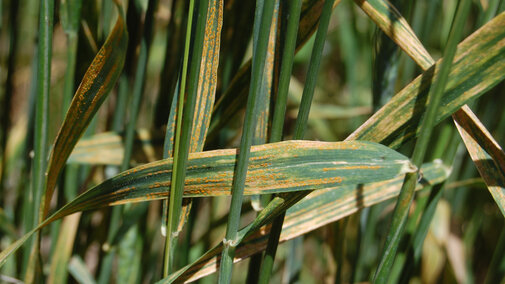This is from a four-part series on stripe rust's history and geographic distribution, biology and life cycle, causes of recent severe epidemics, and management options. Find all the stories on the UNL Panhandle Research and Extension Center website under Panhandle Perspectives.
Stripe rust, caused by the fungal pathogen (Puccinia striiformis f. sp. tritici), is a serious disease of wheat worldwide. Over the last decade, the incidence and severity of damage due to stripe rust has increased dramatically. In Nebraska, the damage to wheat production has been so widespread and severe that it appears stripe rust has displaced the virus disease, wheat steak mosaic, as the most important and economically damaging disease of wheat.
The disease has occurred historically wherever wheat is grown under cool moist environmental conditions during the season. Thus it has been regarded as a low temperature disease and problematic only during cool weather. Since 2000, the disease has emerged to consistently induce severe economic losses in Nebraska, even under very warm conditions where it was thought impossible to thrive. Prior to 2000, it was primarily restricted to the cool damp Pacific Northwest and northern California. After 2000 it began to appear nationwide on all forms of wheat, causing significant losses in areas where it had been rare, including more than 20 states from coast to coast and throughout the entire Great Plains from Texas to North Dakota.


New, Adapted Races May Be Leading to Increase
The formation of new pathogen races is being proposed now to explain the high levels of yield loss and widespread nature of its recent appearance. These races have been demonstrated to cause disease more rapidly and be more aggressive at higher temperatures than previously observed. Furthermore, they have seemingly displaced the old isolates across the expanded geographic ranges, suggesting that the new isolates were more fit than older ones. In doing so, they have additionally overcome the most effective genetic resistance used in the United States wheat crop, converting previously resistant cultivars to susceptible ones.
These remarkable changes indicate that the old pathogen races occurring in cooler climates (before 2000), are distinct from the invasive new isolates occurring in warmer climates after 2000. This suggests that the "new" races were likely recently introduced into the United States from a still unknown location rather than arising as a genetic modification (mutation) from older existing, native isolates.
Managing Stripe Rust
Managing this disease will require several new concepts.
First we need to realize that this pathogen is now capable of causing disease under conditions not previously considered. We also need to accept that it will take an integrated approach to successfully control stripe rust. Management will require multiple control measures, including both fungicide applications and use of resistant cultivars. (See Panhandle Perspectives – August 31, 2016.)

